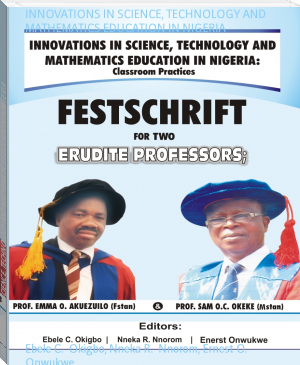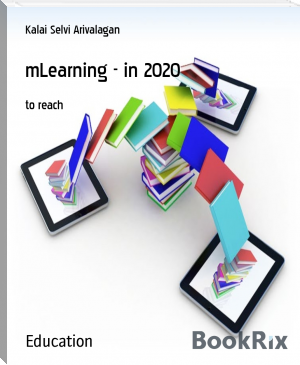INNOVATIONS IN SCIENCE, TECHNOLOGY AND MATHEMATICS EDUCATION IN NIGERIA, Ebele C. Okigbo, Nneka R. Nnorom, Ernest O. Onwukwe [best reads .TXT] 📗

- Author: Ebele C. Okigbo, Nneka R. Nnorom, Ernest O. Onwukwe
Book online «INNOVATIONS IN SCIENCE, TECHNOLOGY AND MATHEMATICS EDUCATION IN NIGERIA, Ebele C. Okigbo, Nneka R. Nnorom, Ernest O. Onwukwe [best reads .TXT] 📗». Author Ebele C. Okigbo, Nneka R. Nnorom, Ernest O. Onwukwe
One of the secrets of the successes recorded in communicating science through art forms is that they create alternative paths to learning; through metaphors and analogies. The other equally very important reason is that they provide means of relaxation and fun and hence make the brain to perceive the activities of the learning process as ‘no treats to life’ since lower energy channels such as ‘smiles’ rather than ‘frowns’ are involved. The brain functions with a regular supply of glucose. Cerebral tasks that may lead to more consumption or burning of glucose than supply are shut down: Fatigue or inability to learn follows. However, the brain can be deceived to continue to open opportunities for learning when it perceives tasks as harmless due to low energy demands. The brain has been found to reject the processing of some information presented to it if such information came from or will likely lead to stress, unhappiness or threat (Gwany, 2005). Plays often remove stress and encourage relaxation and fun. This is particularly helpful to some science students who fear spatial reasoning and numerical manipulations that often attend scientific applications (Carleton College Resource Centre, 2009, Onwukwe, 2005,). Arts provide these low energy channels of learning. Incorporating art forms like drama and so on, will enrich science classrooms more than the so called improved lecture method and far above the traditional and unacceptable sole lecture method.
Many studies have confirmed the claims made in the introduction to write up. The author’s experience in using drama to teach chemistry for more than twenty years and incorporation of other human-oriented and experiential teaching and learning strategies like field trips and multiple students’ projects reveal that students’ academic performance is highly enhanced (Onwukwe, 2017). In fact, as observed by Ijioma (2016), Play-Simulation and Teaching with Analogy, a strategy which the present author propounded in 2010, has been shown to enhance academic achievements of chemistry students, enhance female enrollment in chemistry, eliminate the achievement dichotomy between male and female chemistry students as well as eliminate under-achievement among chemistry students of average cognitive ability.
Science Study and conceptualization
What are concepts?
Demonstration of Conceptualization:
Experience I MAGERY Sound/ Word
Fig 1: Diagrammatic Expression of the conceptualization Process
A concept is a word or a sound that calls up an image of an experience. Concepts help us to communicate experience or to relate it. An experience is not conceptualized if it cannot create a lasting image in the mind of the one making it. In another way, we say, a word or sound is meaningless or non-concept if it does not evoke or call up an image which helps in relational communications. Osuagwu (2005) opines that experience creates concepts and that concepts induce the words used in communicating them.
In much of exact or descriptive science, some concepts are spatial, that is, not easy to make a direct experience of and so do not call up images in the mind easily. Young learners easily avoid tasks dealing with non-concrete concepts. However, since their minds are still developing and will eventually acquire spatial reasoning potentials but may have dropped science or even dropped out of school by that time, something needs to be done to bridge that gap quickly.
What the author does with his humanoid strategies is to bridge the gap between experience and concepts by just creating images that can help the young learner deal with science concepts – that is understand them enough to relate them. The next section of this discussion will explain this idea better.
Humanoid modeling of science instructions
A model is more easily understood as the pictorial, tangible or perceptible form of a mental idea. Life begins with an idea which is translated into a model. With the model, builders or other developers are guided to erect a functional structure. By humanoid, the author means human-oriented. The models try to make science, her processes and operations have human characteristics and appearances so that the learner can relate with them as in the law of solubility: like dissolves like. By bringing the learner, especially the young learner, into such intimacy with the learning material, a filial relationship as organically strong as maternity, paternity or siblinghood is established. Being raised together, in the formative years, a lasting is formed.
Humanoid models of science instructions developed by the author and published include:
Communication Pattern in the Humanoid Strategic Science Instructions.
Diagrams of the structure and processes of science
Drama or role plays for teaching organic and inorganic chemistry.
Lesson Notes. (Please see appendices 2-4)
Lists of analogies usable in teaching chemistry topics (Please see appendix 1)
Communication Pattern in the Humanoid Strategic Science Instructions
It is important to note that in all applications of the humanoid models of science instructions, open conversations in the classroom, driven by well thought out lesson plans are encouraged. An open communication pattern is that whereby the learner is encouraged to express him or herself without any form of restriction. This is especially so in the lower and upper secondary school levels where the adolescent is found. Conformity orientations in classroom conversations lead to low levels of psychosocial knowledge traffic among and between learners. This is because a hierarchy of authority and superiority is already established thereby limiting the free flow and sharing of information and experience. Such will not be typically humanoid, for God Himself will always say ‘Come, let us reason together’. Or ‘Let us make man in our image’. God could do all of that by Himself. However, it took Him a son who had a lineage among men to redeem man. Any Science communication pattern therefore, that inhibits free expression and community will not be humanoid. Please allow the children make activity generated noise during learner friendly or humanoid science instructions Such noise is not nonsense!
The Humanoid Structure and Processes in Science
Normally, the structure and orientations in science can be represented in a diagram as a trident comprising the arm which is science itself. The prongs are products of science, processes of science and attitudes/orientations in science:
However, to make it humanoid and perhaps, more attractive and interesting to the leaner, the diagram shown below is rather used to teach this concept. For gender balance, young girls and boys are encouraged by the feminine and masculine appearing variants of the model, (Onwukwe, Ngozi-Olehi, NnadiandIbe, 2005)
Masculine Appearing Variants Model
Feminine Appearing Variants Model
(The masculine variant)
What has entropy to do with learning potentials?
Let us look at entropy from a slightly different perspective than its usual thermodynamic and statistics notion while still borrowing from both disciplines to apply the term to learning potentials. Let me define ‘Learners’ entropy’ as the tendency of learners to move in all directions in search of information and solutions unhindered by the confines of the classroom and its grand norms. Any teaching and learning approach that increases this tendency is highly humanoid and has a high learners’ entropy. Therefore, learners’ entropy of an instructional mode or approach is a measure of the opportunities inherent in it for learners to ‘freely exercise their bodies and minds openly in the direction of a clearly defined problem’. A teaching and learning approach that has high learners’ entropy will definitely involve:
Learners’ movement in all directions and as frequent as possible
All forms of communicative expressions and to any degree possible
Spontaneous self-grouping and re-grouping of learners as much as possible
Many natural obstacles and varied types and degrees of attempts to resolve them
Some injuries and losses that may or may not be reported.
Science instruction approaches must therefore have high learners’ entropy. In this way, their contact with nature and their potential to learn will be highly increased. The author can boast of and have equally applied a number of humanoid science instruction strategies with high learners’ entropy that justified themselves; examples include teaching students through project works, field trips and other experiential learner friendly approaches.
References
Carleton College Resource Centre. How teach using role-playing (n.d). Retrieved 20th September, 2009, from http://serc.carleton.edu/intorgeo/roleplaying/howto.html
Gwany, D.M. (2005) The psychology of learning, brain hemisphericity and learners’ Educational Millieux; perspectives and challenges. The Educational Psychologist,1, 2.9 -17.
Ijioma, B. C., (2016) Sustaining Development In Science And Technology Education In Nigeria Through Functional Research. 1st Inaugural Lecture of Alvan Ikoku Federal College of Education, Owerri – Nigeria.16thAugust, 2016.
Ijioma, B.C & Onwukwe, E.O (2011) using culturally – based analogical concepts in teaching secondary school science: Model of a lesson plan. Int. J.Sci Technology Edu. Res 2(1), 1-5.
Mary, A., Ramirez, C., Clement, J. & Else, M., (2002). When are analogies the right tool? A look at the strategic use of analogies in teaching cellular respiration to middle school students. Retrieved October, 5th, 2009 fromww.ed.edu/journal web.
Onwukwe, E.O. (2005) Teaching and learning science through plays, chemistry: court room of crazy elements. Owerri: Reliable Pub.
Onwukwe, E.O. (2005). Teaching and learning science through plays, chemistry. Queen Ester’s Father. Owerri: Reliable Pub.
Onwukwe, E.O. (2017). Field trips and projects versus students’ academic performance. Owerri: Divine Favour Concepts Pub.
EFFECT OF HANDS-ON KNOWLEDGE CONCEPT (HKC)
ON STUDENTS’ ACHIEVEMENT IN GEOMETRY
Celestine, Njoku
&
Amaka B. Chiakwelu
Abstract
The study investigated the effect of Hands-on Knowledge Concept (HKC) of three-dimensional shapes on students’ achievement in geometry in Abia State, Nigeria. It also determined the influence of gender on the achievement of students. The design of the study was quasi experimental design, specifically the non-equivalent control group. The sample of the study was 274(123 male and 151 female) SS2 students selected through a multistage sampling procedure. Three Dimensional Shapes Achievement Test (TDSAT) was used as instrument for data collection. The instrument was face and content validated by experts and also trial tested. Item analysis was conducted on TDSAT in order to fully standardize the instrument. The reliability of TDSAT was established using Kuder Richardson formula 20 (KR-20) which was found to be 0.79 for internal consistency. Test-retest which was found to be 0.82 was used to estimate the temporal stability of TDSAT.Mean and standard deviation were used to answer the research questions while Two- way Analysis of Co-variance (ANCOVA) was used to test the hypotheses at 0.05 level of significant.The data analysis revealed that teaching method has significant effect on students’ mean achievement scores in geometry; gender has no significant influence on students’ achievement scores in geometry and the interaction effect of teaching method and gender on students’ achievement scores in geometry is not significant. Based on the findings from the study, it was therefore recommended that mathematics teachers should expose students to HKC for meaningful and effective teaching and learning of three-dimensional shapes in mathematics.
Keywords: Three Dimensional Shapes, Achievement in Geometry and Hands-on Knowledge Concept.
Introduction
The indispensable tool that shapes the society and makes it habitable is education. Therefore, education is important for everyone in the society irrespective of social and physical status. In line with the opinion, Uchem, Ngwa, and Asogwa (2014) asserted that education is a foundational right for the sustainability of socio-political economic transformation of any society. Matthew (2016) opined that no society would achieve greatness without adequate supply of scientists and technologists who would be critical to the growth and development of the society, hence the need for good knowledge of Mathematics is necessary in order to produce scientists and technologists.
Mathematics is a discipline that aims at understanding the world by symbolically and systematically performing reasoning and computation on abstract structures (Joshua, 2016). Ordinarily, man can necessarily survive without learning how to read and write, but cannot sufficiently survive without learning





Comments (0)